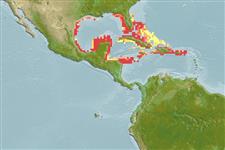>
Blenniiformes (Blennies) >
Chaenopsidae (Pike-, tube- and flagblennies)
Etymology: Emblemaria: Latin, emblema = insertion, inlaid work, raised ornament (Ref. 45335).
More on authors: Ginsburg & Reid.
Environment: milieu / climate zone / depth range / distribution range
Ecologia
marinhas associadas(os) a recifes; intervalo de profundidade 0 - 30 m (Ref. 9710). Tropical; 30°N - 15°N, 98°W - 64°W
Western Central Atlantic: northeastern Gulf of Mexico in USA (Ref. 7251). Believed to have a continental distribution but has since been reported from Belize (provisional identification), Puerto Rico and the US Virgin Islands (Ref. 51183).
Tamanho / Peso / Idade
Maturity: Lm ? range ? - ? cm
Max length : 5.0 cm TL macho/indeterminado; (Ref. 7251)
Descrição suscinta
Morfologia | Morfometria
Espinhos dorsais (total): 17 - 20; Raios dorsais (total): 14-16; Espinhos anais 2; Raios anais : 20 - 21; Vértebras: 39 - 40. Species distinguished by: dorsal-fin spines 17 to 20; dorsal-fin rays 14 to 16; total dorsal-fin elements 30 to 38; anal-fin rays 20 or 21; vertebrae 39 or 40; pectoral-fin rays 13; 2 obvious segmented pelvic-fin rays (third ray vestigial or goes 5 or more times in length of longest); cirrus on eye arising from a single base, longer than eye diameter in males (and often in females); head smooth anteriorly, never spiny; tip of lower jaw not projecting beyond tip of upper jaw and without fleshy projection; no stripe or series of dark blotches on head and body; one row of teeth on each palatine bone. Common amongst Chaenopsids: small elongate fishes; largest species about 12 cm SL, most under 5 cm SL. Head usually with cirri or fleshy flaps on anterior nostrils, eyes, and sometimes laterally on nape; gill membranes continuous with each other across posteroventral surface of head. Each jaw with canine-like or incisor-like teeth anteriorly; teeth usually also present on vomer and often on palatines (roof of mouth). Dorsal-fin spines flexible, usually outnumbering the segmented soft rays, spinous and segmented-rayed portions forming a single, continuous fin; 2 flexible spines in anal fin; pelvic fins inserted anterior to position of pectoral fins, with 1 spine not visible externally and only 2 or 3 segmented (soft) rays; all fin rays, including caudal-fin rays, unbranched (simple). Lateral line absent. Scales absent (Ref.52855).
Occurs from the shoreline to deep rocky and coral reefs (Ref. 9710).
Ciclo de vida ou comportamento de acasalamento
Maturidade | Reprodução | Desova | Ovos | Fecundidade | Larvas
Robins, C.R. and G.C. Ray, 1986. A field guide to Atlantic coast fishes of North America. Houghton Mifflin Company, Boston, U.S.A. 354 p. (Ref. 7251)
Status na Lista Vermelha da UICN (Ref. 130435)
Ameaça para os humanos
Harmless
Uso pelos humanos
Aquário: Espécies comerciais
Mais informação
Nomes comunsSinônimosMetabolismoPredadoresEcotoxicologiaReproduçãoMaturidadeDesovaAgregação de desovaFecundidadeOvosDesenvolvimento dos ovos
Idade/TamanhoCrescimentoPeso-comprimentoComprimento-comprimentoFrequências de comprimentoMorfometriaMorfologiaLarvasDinâmica larvalRecrutamentoAbundânciaBRUVS
ReferênciasAquaculturaPerfil para aquaculturaEstirpesGenéticaElectrophoresesHereditariedadeDoençasProcessamentoNutrientsConversão de massa
ColaboradoresFotosStamps, Coins Misc.SonsCiguateraVelocidadeTipo de nataçãoÁrea branquialOtólitosCérebrosVisão
Ferramentas
Relatórios especiais
Baixar XML
Fontes da internet
Estimates based on models
Preferred temperature (Ref.
123201): 23.6 - 28, mean 26.5 °C (based on 231 cells).
Índice de diversidade filogenética (Ref.
82804): PD
50 = 0.5000 [Uniqueness, from 0.5 = low to 2.0 = high].
Bayesian length-weight: a=0.00457 (0.00183 - 0.01143), b=3.08 (2.86 - 3.30), in cm total length, based on LWR estimates for this (Sub)family-body shape (Ref.
93245).
Nível Trófico (Ref.
69278): 3.4 ±0.4 se; based on size and trophs of closest relatives
Fishing Vulnerability (Ref.
59153): Low vulnerability (10 of 100).
